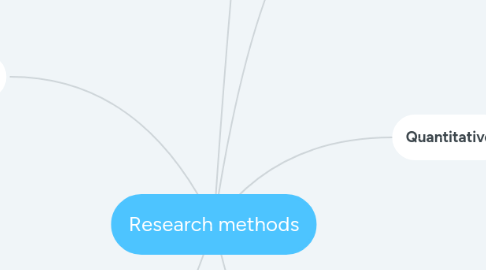
1. consideration
1.1. practical
1.1.1. time
1.1.2. money
1.1.3. access
1.1.4. ways to record data
1.2. ethical
1.2.1. confidentiality
1.2.1.1. Privacy
1.2.2. Consent form
1.2.3. law
1.3. theoritical
1.3.1. Validity
1.3.1.1. How accurate the research is
1.3.1.2. If the research is valid, it tends to be reliable.
1.3.2. Representitive
1.3.2.1. Show the characteristic of a group
1.3.3. Reliability
1.3.3.1. Free of bias
1.3.3.2. Using constant method
1.3.3.3. Repeatable
1.3.4. Generalisability
1.3.4.1. The result can apply for other group
1.3.5. Reflexivity
1.3.5.1. Researches can be affected by researchers
1.3.5.2. Researchers can affect the result of research.
2. mixed approach
2.1. methodological pluralism
2.2. triangulation
2.3. case study
2.4. longitudinal study
2.4.1. longitudinal study is a research conducted over an extended period of time
2.4.2. theoriticla problem
3. Quantitative
3.1. Posivist
3.1.1. Auguste Comte
3.1.2. Try to find social facts
3.1.2.1. Life can be reduced to series of facts.
3.1.2.2. Everyone has the same reality.
3.1.2.3. If we understand some facts, we can understand whole of society.
3.2. Ethnographic observation
3.2.1. Ethnographic observation involves doing field research to observe people researcher are trying to relate to and understand. “Ethnographers attempt to record, in an orderly manner, how natives behave and how they explain their behavior
3.3. Numerical data
4. Qualitative
4.1. interpetivist: focuses on the importance of meaning and action
4.1.1. Overt observation
4.1.1.1. Disadvantage: research are less ethical
4.1.2. covert observation
4.1.2.1. hawthorne effect
4.1.2.1.1. is a term referring to the tendency of some people to work harder and perform better when they are participants in an experiment
4.1.3. Social artifacts
4.1.3.1. person reflect their part of life
4.1.3.2. everything you own, produce or view can be analysed to identify
4.1.4. cultural capital
4.1.4.1. Ex. education(undergraduate degree), glasses
4.1.5. Try to find social construct
4.1.5.1. Everyone has different reality
4.1.5.2. Life cannot be reduced to series of facts.
4.1.5.3. We have to understand everyone's own reality.
4.2. Non-numerical data such as comments
5. Primary research
5.1. ethnography
5.1.1. Study culture, sometimes live in the area.
5.1.2. netograph/micro-ethnography
5.1.3. plummer
5.2. Sampling
5.2.1. quota sampling
5.2.1.1. Decide a specific group and choose them randomly
5.2.2. stratified
5.2.2.1. Decide a specific group and choose them based on a specific criteria.
5.2.3. snowball
5.3. interview
5.3.1. Group interview
5.3.1.1. interviewer asks questions to two or more people at one time
5.3.2. Structured interview
5.3.2.1. Like surveys, questions are fixed and the interviewer follows careful instruction. This includes asking questions in same tone of voice and wording each time
5.3.3. Semi structured interview
5.3.3.1. interviewer has a list of questions prepared, but can go into more depth with follow-up discussion
5.3.4. Unstructured interview
5.3.4.1. Need rapport
5.3.4.2. interviewer tries to discover information, in a kind of guided conversation. They ask whatever questions, they want, changing the words, but focused on on purpose
5.3.5. Focus group interview
5.3.5.1. interviewer asks questions to two or more people at one time, and allows them to discuss with each other
5.3.6. prompt/probe/rapport
5.4. experiment
5.4.1. Hawthorne effect
5.4.1.1. The Hawthorne effect refers to the increase in performance of individuals who are noticed, watched, and paid attention to by researchers or supervisors
5.4.2. laboratory
5.4.3. field
5.4.4. attempt to test a hypothesis under highly controlled condition
5.5. The research conducted by myself.
5.6. questionnaire
5.6.1. closed
5.6.2. open
6. Secondary research
6.1. The research which someone has already done.
6.2. example
6.2.1. Books
6.2.2. social artifact
6.2.2.1. Aims to analyse people
6.2.2.2. E.g. internet browsing history
